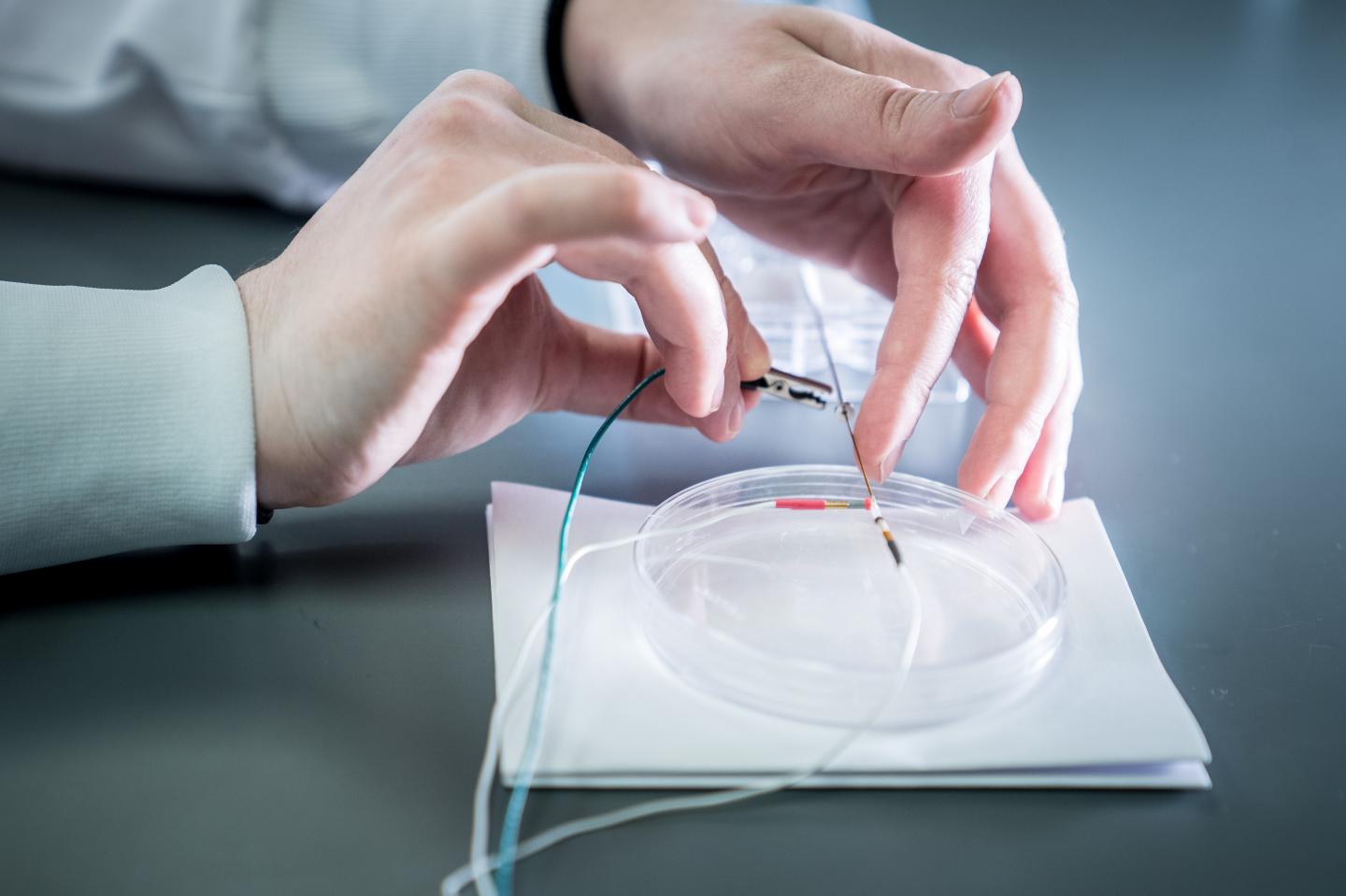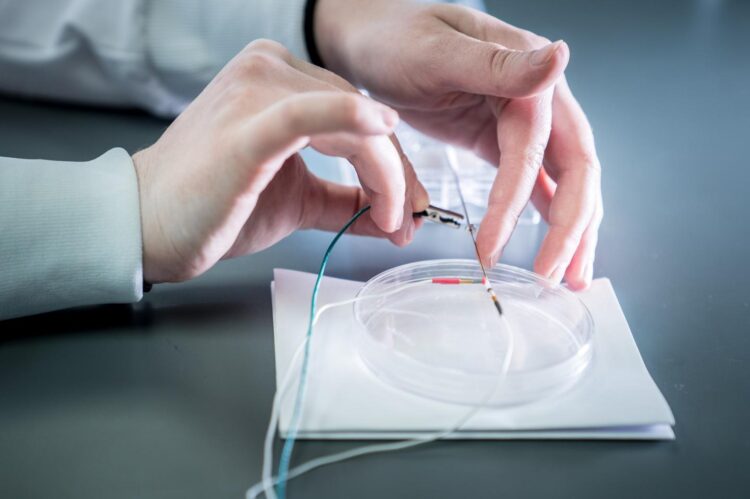Dopamine, serotonin involved in sub-second perception, cognition

Credit: Virginia Tech
In first-of-their-kind observations in the human brain, an international team of researchers has revealed two well-known neurochemicals — dopamine and serotonin — are at work at sub-second speeds to shape how people perceive the world and take action based on their perception.
The discovery shows researchers can continually and simultaneously measure the activity of both dopamine and serotonin — whose receptor and uptake sites are therapeutic targets for disorders ranging from depression to Parkinson’s disease — in the human brain.
Furthermore, the neurochemicals appear to integrate people’s perceptions of the world with their actions, indicating dopamine and serotonin have far more expansive roles in the human nervous system than previously known.
Known as neuromodulators, dopamine and serotonin have traditionally been linked to reward processing — how good or how bad people perceive an outcome to be after taking an action.
The study online today in the journal Neuron opens the door to a deeper understanding of an expanded role for these systems and their roles in human health.
“An enormous number of people throughout the world are taking pharmaceutical compounds to perturb the dopamine and serotonin transmitter systems to change their behavior and mental health,” said P. Read Montague, senior author of the study and a professor and director of the Center for Human Neuroscience Research and the Human Neuroimaging Laboratory at the Fralin Biomedical Research Institute at Virginia Tech Carilion. “For the first time, moment-to-moment activity in these systems has been measured and determined to be involved in perception and cognitive capacities. These neurotransmitters are simultaneously acting and integrating activity across vastly different time and space scales than anyone expected.”
Better understanding of the underlying actions of dopamine and serotonin during perception and decision-making could deliver important insight into psychiatric and neurological disorders, the researchers said.
“Every choice that someone executes involves taking in information, interpreting that information, and making decisions about what they perceived,” said Kenneth Kishida, a corresponding author of the study and an assistant professor of physiology and pharmacology, and neurosurgery, at Wake Forest School of Medicine. “There’s a whole host of psychiatric conditions and neurological disorders where that process is altered in the patients, and dopamine and serotonin are prime suspects.”
Lack of chemically specific methods to study neuromodulation in humans at fast time scales has impeded understanding of these systems, according to Montague, who is an honorary professor at the Wellcome Center for Human Neuroimaging at University College London and a professor of physics at the Virginia Tech College of Science.
But now, in first-ever measurements, scientists used an electrochemical method called “fast scan cyclic voltammetry,” which employs a small carbon fiber microelectrode that has low voltages ramped across it for real-time detection of dopamine and serotonin activity.
In the study, researchers recorded fluctuations in dopamine and serotonin using specially designed electrodes in five patients undergoing deep brain stimulation electrode implantation surgery to treat essential tremor or Parkinson’s disease. Patients were awake during surgery, playing a computer game designed to quantify aspects of thought and behavior while the measurements were taken.
On each round of the game, patients briefly viewed a cloud of dots and were asked to judge the direction they were moving. The method, designed by corresponding author Dan Bang, a Sir Henry Wellcome Postdoctoral Fellow, and Steve Fleming, a Sir Henry Dale/Royal Society Fellow, both at the Wellcome Center for Human Neuroimaging at University College London, helped indicate that dopamine and serotonin were involved in simple perceptual decisions, outside of the traditional context of rewards and losses.
“These neuromodulators play a much broader role in supporting human behavior and thought, and in particular they are involved in how we process the outside world,” Bang said. “For example, if you move through a room and the lights are off, you move differently because you’re uncertain about where objects are. Our work suggests these neuromodulators — serotonin in particular– are playing a role in signaling how uncertain we are about the outside environment.”
Montague and Kishida, along with Terry Lohrenz, a research assistant professor, and Jason White, a senior research associate, now both at the Fralin Biomedical Research Institute, started working on a new statistical approach to identify dopamine and serotonin signals while still at the Baylor College of Medicine in Houston, Texas.
“Ken rose to the challenge of doing fast neurochemistry in human beings during active cognition,” Montague said. “A lot of other good groups of scientists were not able to do it. Aside from the computation of enormous amounts of data, there are complicated issues to solve, including great, fundamental algorithmic tasks.”
Until recently, only slow methodologies such as PET scanning could measure the impact of neurotransmitters, but they were nowhere near the frequency or volume of the second-to-second measurements of fast scan cyclic voltammetry.
The measurements in the new study were taken at the Wake Forest Baptist Medical Center, and involved neurosurgical teams led by Adrian W. Laxton and Stephen B. Tatter.
“The enthusiasm the neurosurgeons have for this research is derived from the same reasons that drove them to be doctors — first and foremost, they want to do the best for their patients, and they have a real passion for understanding how the brain works to improve patient outcomes,” said Kishida, who oversaw the data collection in the operating room during the surgeries. “Both are collaborative scientists along with Charles Branch, the chair of the neurosurgery department at Wake Forest, who has been an amazing advocate for this work.”
Likewise, Montague said, “You can’t do it without the surgeons being real, shoulder-to-shoulder partners, and certainly not without the people who let you make recordings from their brains while they are having electrodes implanted to alleviate the symptoms of a neurological disorder.”
Montague had read a study in the Proceedings of the National Academy of Sciences that prompted him to approach colleagues Bang and Fleming at University College London to tailor a task for patients to perform during surgery that would reveal sub-second dopamine and serotonin signaling in real-time inference about the external world – separate from their often-reported roles in reward-related processes.
“I said I have this new method to measure dopamine and serotonin, but I need you to help with the task,” Montague said. “They ended up in the study. The research really took a lot of hard work and an integrated a constellation of people to obtain these results.”
The research was funded by grants to various researchers from the Wellcome Trust, the National Institutes of Health including the National Institute on Drug Abuse, the National Institute of Mental Health, the National Institute of Neurological Disorders and Stroke.
###
Media Contact
John Pastor
[email protected]
Related Journal Article
http://dx.





